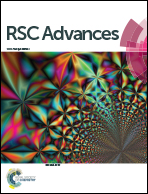Unique quenching of fluorescent copper nanoclusters based on target-induced oxidation effect: a simple, label-free, highly sensitive and specific bleomycin assay†
Abstract
In this contribution, a novel label-free fluorescence biosensor for bleomycin (BLM) detection was developed by combining the excellent fluorescence properties of copper nanoclusters (CuNCs) and the unique oxidation capability of a BLM–Fe2+ complex toward CuNCs. The CuNCs probe was prepared through in situ formation of CuNCs using single-stranded DNAs as the templates, endowing the probe with good water-dispersibility that is important for analyzing biological samples. After their recognition of BLM, the CuNCs were destroyed and the red fluorescence of the probe was quenched, thus realizing the detection of BLM. Such a fluorescence sensing strategy allows for highly sensitive BLM biosensing with a detection limit as low as 0.26 nM and minimal interference from complex mixtures. Compared to previously reported methods, the as-proposed assay does not need specific DNA sequences, complex designing or signal molecule labeling, and further avoids tedious experimental procedures, thus providing the strategy with additional advantages of simplicity and cost-effectiveness. Furthermore, our probe was also adopted for the detection of BLM in human serum samples and excellent performance was achieved, which makes the as-proposed strategy a promising candidate for highly sensitive and specific analysis of BLM in cancer treatment.



 Please wait while we load your content...
Please wait while we load your content...